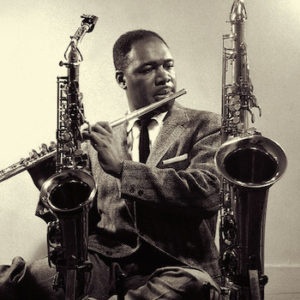
Buddy Collette
*Buddy Collette was born on this date in 1921. He was a Black jazz flutist, saxophonist, and clarinetist.
William Marcel Collette was born in Los Angeles and raised in Watts, surrounded by people of different ethnicities. He lived in a house built by his father in an area with cheap, plentiful land. The neighborhood in which he grew up was called the Central Gardens area. He attended Ninety-sixth Street School for elementary school because it allowed black students. Other schools in the area, such as South Gate Junior High School, did not, and Collette often felt odd entering areas primarily inhabited by whites.
Collette's family did not have a lot of money, but his childhood gave him a chance to mix with different people. The "melting pot" of Watts framed how he saw his position as a black man in the future. Collette began playing piano at age ten, at his grandmother's request. His love for music came from his community and his parents—his father played piano, and his mother sang. In middle school, he began playing the saxophone. That same year, he formed his first band. The following year, Collette started a band with Ralph Bledsoe and Raleigh Bledsoe.
They played for less than a dollar each at parties put on by people in the area on Saturday nights. Collette started a third group, including Charles Mingus on bass. Collette and Mingus became terrific friends, and Collette helped Mingus find his less wild, more reserved side. During his childhood, Collette had plenty of musicians to admire. Collette became a part of the Woodman brothers' band when he was fifteen. Collette credits the Woodman brothers with finding the jazz sound of Watts. He traveled to Los Angeles during high school to connect with other musicians.
At the Million Dollar Theatre, he and his band competed in a battle of the bands but lost to a band that included Jackie Kelson, Chico Hamilton, and Al Adams. Afterward, Collette joined the winning band, making twenty-one dollars per week. Later, Mingus joined too. At 19, Collette started taking musical lessons from Lloyd Reese, who also taught Eric Dolphy, Mingus, and others. Collette credits Reese with teaching him and the other musicians how to manage themselves in the music world.
Collette served with the US Navy band attached to the pre-flight school at St. Mary's College during World War II. Led by Marshal Royal, it was one of two regimental bands of Black musicians. Two dance bands were formed from that band of 45 musicians, the first being the Bombardiers, led by Royal. The second dance band, the Topflighters, was led by Collette. His memoir records a trip that he, Bill Douglass, and Mingus made from Los Angeles to San Francisco in October 1942 after hearing that a Navy officer was recruiting musicians from the union there to serve in an all-black band stationed at St. Mary's. Both Mingus and Douglass changed their minds, however. The Army later drafted Douglass; Mingus got re-classified 4-F. Collette was at the Great Lakes, Chicago, a complex of Navy bases.
After serving as a US Navy band leader, he played with Louis Jordan and Benny Carter. In 1949, he was the only Black member of the band for You Bet Your Life, a TV and radio show. In the 1950s, he worked as a studio musician with Frank Sinatra, Ella Fitzgerald, Duke Ellington, Count Basie, Nat King Cole, and Nelson Riddle.
In 1955 he was a founding member of the Chico Hamilton Quintet. He also taught, and his students included Mingus, James Newton, Dolphy, Charles Lloyd, and Frank Morgan. Furthermore, Collette collaborated with the Community Symphony Orchestra in Los Angeles, the Gerald Wilson Orchestra, and was a musical director for the jazz band program at Loyola Marymount University.
Around the early 1900s, Los Angeles had two music unions: Local 47, a union for white musicians, and Local 767, a union for black musicians. Collette and several other black musicians concentrated on merging the two unions into one color-blind union in the early 1950s. Initially, the merge existed as an interracial symphony performing at the Humanist Hall on Twenty-third and Union. The success of this group led to the coalition of the two segregated locals. Collette eventually made the board of Local 767 as vice president.
His career as a musician produced a comprehensive discography and created and transformed numerous musicians. Towards the latter half of his career, Collette was in demand to teach seminars and music clinics in universities nationwide. Collette taught and mentored within the Watts district of Los Angeles but later began traveling and performing. One of his most notable affiliations is with the UCLA oral history program, where he was a key contributor to the Central Avenue Sounds program.
Collette also joined the faculty at California State University, Pomona campus, in 1992, where he was a jazz and combo band conductor. Collette also held faculty positions at CSULB, California State University Dominguez Hills, and Loyola Marymount University. He was designated a Los Angeles Living Cultural Treasure by Los Angeles in the late 1990s. Collette's legacy lives on through the JazzAmerica program, a non-profit organization he co-founded in 1994 that aims to bring jazz into classrooms in middle and high schools in the greater Los Angeles area tuition-free. Buddy Collette died in Los Angeles of heart failure at 89 on September 19, 2010.